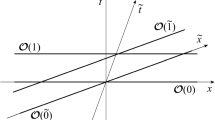Summary
An analysis of the foundations of quantum mechanics shows that two distinct procedures are involved therein: quantization of space-time, and the linking of a mechanical model to the quantized space-time (Q.S.T.). The former is calledl-quantization, the latterh-quantization for reasons to be explained in the text. The point model of elementary particle is found to be rather unnatural while a bipoint model fits naturally into the framework of Q.S.T. Among the possible bi-point models a rotator model is preferable fitting smoothly to the covariance properties of Q.S.T.. The rest mass of the bi-point particle is no more a parameter introduced ad hoc but is determined by the momenta of the internal motion of the particle. A bilocal field theory based on the bi-point (rotator) model of the elementary physical entity is constructed: field equations are set up as well as the current four-vector, energy-momentum tensor, and angular momentum tensor densities satisfying differential conservation laws. The bilocal field may be quantized and describes a whole set (family) of particle sorts with higher spins and masses corresponding to the excited states of the underlying rotator model. There is a one-to-one correspondence between the particle types forming a family and the irreducible unitary representations of the group of rotations which fact exhibits an intimate and complete connection between space and matter. The particle families may be classified according to single-or double-valuedness of field quantities, according to the type of symmetry with respect to inversions, and according to the order of the field equation. A comparison with the present experimental evidence about elementary particles (rest-mass values, decay schemes, etc.) seems promising.
Riassunto
L’analisi dei fondamenti della meccanica quantistica mostra che essa comprende due procedimenti distinti: la quantizzazione dello spazio-tempo e il collegamento di un modello meccanico allo spazio-tempo quantizzato (Q.S.T.). Per ragioni spiegate nel testo, il primo di questi procedimenti si dice quantizzazionel, il secondo quantizzazioneh. Si trova che per le particelle elementari il modello puntiforme non risulta naturale, mentre un modello bipuntuale si inserisce naturalmente nel quadro della Q.S.T. Tra i possibili modelli bipuntuali è preferibile un modello a rotatore che si adatta docilmente alle proprietà di covarianza della Q.T.S. La massa a riposo della particella bipuntuale non è più un parametro introdotto espressamente ma è determinata dalle quantità di moto derivanti dai moti interni della particella. Si costruisce una teoria di campo bilocale basata sul modello bipuntuale (rotatore) dell’entità fisica elementare: si impostano equazioni di campo, nonchè le densità del quadrivettore corrente, del tensore energia-quantità di moto, e del tensore momento angolare, densità che soddisfano leggi di conservazione differenziali. Il campo bilocale può essere quantizzato e descrive un’intera serie (famiglia) di specie di particelle con spin d’ordini superiori e masse corrispondenti agli stati eccitati del modello a rotatore preso per base. Si ha corrispondenza biunivoca tra i tipi di particelle che formano una famiglia e le rappresentazioni unitarie irriducibili del gruppo di rotazioni, il che dimostra un’intima e completa connessione tra spazio e materia. Le famiglie di particelle si possono classificare a seconda della mono o bivalenza delle grandezze di campo, a seconda del tipo di simmetria rispetto alle inversioni, e a seconda dell’ordine dell’equazione di campo. Il confronto con i dati sperimentali disponibili sulle particelle elementari (valori di massa a riposo, schemi di decadimento, ecc.) sembra dare risultati promettenti.
Similar content being viewed by others
ReferencesReferences
M. Born:Rev. Mod. Phys.,21, 463 (1949).
J. Rayski:Proc. Phys. Soc.,64, 957 (1951).
J. Rayski:Acta Phys. Pol.,14, (1955a).
J. Rayski:Acta Phys. Pol.,14, (1955b) (in the press).
H. Yukawa:Phys. Rev.,77, 219 (1950).
H. Yukawa:Phys. Rev.,91, 415 (1953).
Author information
Authors and Affiliations
Rights and permissions
About this article
Cite this article
Rayski, J. On the meaning of bilocalizability. Nuovo Cim 2, 255–272 (1955). https://doi.org/10.1007/BF02855918
Received:
Published:
Issue Date:
DOI: https://doi.org/10.1007/BF02855918




